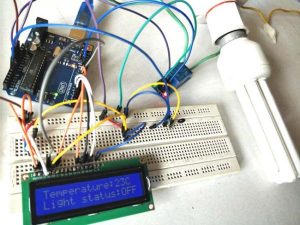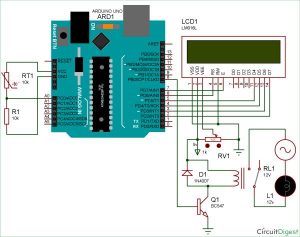Suppose you are sitting in a room and feeling cold and you want your heater to be automatically turned on, and then off after some time when room temperature is increased, then this project help you to control your home appliances automatically according to the temperature. Here we are controlling Home AC Appliances with Arduino based on the temperature. Here we have used Thermistor to read the temperature. We already interfaced Thermistor with Arduino and displayed the Temperature on LCD.
In this tutorial, we will attach a AC appliance with Relay and make a temperature controlled home automation system using Arduino. It also shows the temperature and appliance status on the 16*2 LCD display connected with the circuit.
Material Required
- Arduino UNO
- Relay (5v)
- 16*2 LCD display
- Light Bulb (CFL)
- NTC thermistor 10k
- Connecting wires
- Resistors (1k and 10k ohms)
- Potentiometer (10k)
This Temperature based Home Automation System consists of various components like Arduino board, LCD display, Relay, and thermistor. The working mainly depends on the relay and thermistor as the temperature increased the relay will be turned on and if the temperature decreased below the preset value then Relay will be turned off. The Home appliance connected with the Relay will also turns on and off accordingly. Here we have used a CFL bulb as AC appliance. The whole triggering process and temperature value setting is performed by the programmed Arduino board. It also gives us details about the change in temperature in every half second and appliance status on the LCD screen.
Relay:
Relay is an electromagnetic switch, which is controlled by small current, and used to switch ON and OFF relatively much larger current. Means by applying small current we can switch ON the relay which allows much larger current to flow. A relay is a good example of controlling the AC (alternate current) devices, using a much smaller DC current. Commonly used Relay is Single Pole Double Throw (SPDT) Relay.
When there is no voltage applied to the coil, COM (common) is connected to NC (normally closed contact). When there is some voltage applied to the coil, the electromagnetic field produced, which attracts the Armature (lever connected to spring), and COM and NO (normally open contact) gets connected, which allow a larger current to flow. Relays are available in many ratings, here we used 5V operating voltage relay, which allows 7A-250VAC current to flow.
The relay is configured by using a small Driver circuit which consists a Transistor, Diode and a resistor. Transistor is used to amplify the current so that full current (from the DC source – 9v battery) can flow through a coil to fully energies it. The resistor is used to provide biasing to the transistor. And Diode is used to prevent reverse current flow, when the transistor is switched OFF. Every Inductor coil produces equal and opposite EMF when switched OFF suddenly, this may cause permanent damage to components, so Diode must be used to prevent reverse current. A Relay module is easily available in the market with all its Driver circuit on the board or you can create it by using above components. Here we have used 5V Relay module.
Read More: La température est Contrôlée AC Appareils électroménagers à l'aide d'Arduino et de Thermistance


